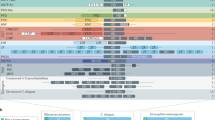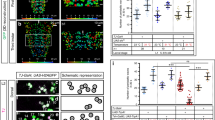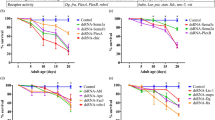Abstract
IDENTIFICATION of the genes orchestrating neurogenesis would greatly enhance our understanding of this process. Genes have been identified that specify neuron type (for examplecut1 and numb2 inDrosophila andmec-3 in Caenorhabditis elegans3) and process guidance (for example,unc-5,unc-6 andunc-40 inC. elegans4and thefas-1 gene of Drosophila5). We sought genes defining synaptic specificity by identifying mutations that alter synaptic connectivity in the motor circuitry in the nematodeC.elegans. We used electron microscopy of serial sections6 to recon-struct the ventral nerve-cords of uncoordinated (unc) mutants7,8 that have distinctive locomotory choreographies. Here we describe the phenotype of mutations in theunc-4 gene in which a locomotory defect is correlated with specific changes in synaptic input to a subset of the excitatory VA motor neurons, normally used in reverse locomotion. The circuitry alterations do not arise because of the inaccessibility of the appropriate synaptic partners, but are a consequence of changes in synaptic specificity. The VA motor neurons with altered synaptic inputs are all lineal sisters of VB motor neurons; the VA motor neurons without VB sisters have essentially the same synaptic inputs as in wild-type animals. The normal function of the wild-type allele of unc-4 may thus be to invoke the appropriate synaptic specificities to VA motor neurons produced in particular developmental contexts.
This is a preview of subscription content, access via your institution
Access options
Subscribe to this journal
Receive 51 print issues and online access
$199.00 per year
only $3.90 per issue
Buy this article
- Purchase on Springer Link
- Instant access to full article PDF
Prices may be subject to local taxes which are calculated during checkout
Similar content being viewed by others
References
Blochlinger, K., Bodmer, R., Jack, J., Jan, L. Y. & Jan, Y. N. Nature 333, 629–635 (1988).
Uemura, T., Shepherd, S., Ackerman, L., Jan, L. Y. & Jan, Y. N. Cell 58, 349–360 (1989).
Way, J. C. & Chalfie, M. Cell 54, 5–16 (1988).
Hedgecock, E. M., Culotti, J. G. & Hall, D. H. Neuron 2, 61–85 (1990).
Elkins, T., Zinn, K., McAllister, L., Hoffman, F. M. & Goodman, C. S. Cell 60, 565–575 (1990).
White, J. G., Southgate, E., Thomson, J. N. & Brenner, S. Phil. Trans. R. Soc. B 314, 1–340 (1986).
Brenner, S. Genetics 77, 71–94 (1974).
Wood, W. B. (ed.) The Nematode Caenorhabditis elegans (Cold Spring Harbor Laboratory Press, New York, 1988).
Chalfie, M. et al. J. Neurosci. 5, 956–964 (1985).
Miller, D. M. et al. Nature 355, 841–845 (1992).
Sulston, J. E. & Horvitz, H. R. Devl Biol. 56, 110–156 (1977).
Sulston, J. E., Schierenberg, E., White, J. G. & Thomson, J. N. Devl Biol. 100, 64–119 (1983).
Desai, C., Garriga, G., McIntyre, S. L. & Horvitz, H. R. Nature 336, 638–646 (1988).
Durbin, R. M. thesis, Cambridge Univ. (1987).
Author information
Authors and Affiliations
Rights and permissions
About this article
Cite this article
White, J., Southgate, E. & Thomson, J. Mutations in the Caenorhabditis elegans unc–4 gene alter the synaptic input to ventral cord motor neurons. Nature 355, 838–841 (1992). https://doi.org/10.1038/355838a0
Received:
Accepted:
Issue Date:
DOI: https://doi.org/10.1038/355838a0
This article is cited by
-
Homeobox genes and the specification of neuronal identity
Nature Reviews Neuroscience (2021)
-
Unique homeobox codes delineate all the neuron classes of C. elegans
Nature (2020)
-
The transcription factor Uncx4.1 acts in a short window of midbrain dopaminergic neuron differentiation
Neural Development (2012)
-
A gene expression fingerprint of C. elegans embryonic motor neurons
BMC Genomics (2005)
-
Dlx-2 homeobox gene controls neuronal differentiation in primary cultures of developing basal ganglia
Journal of Molecular Neuroscience (1997)
Comments
By submitting a comment you agree to abide by our Terms and Community Guidelines. If you find something abusive or that does not comply with our terms or guidelines please flag it as inappropriate.



